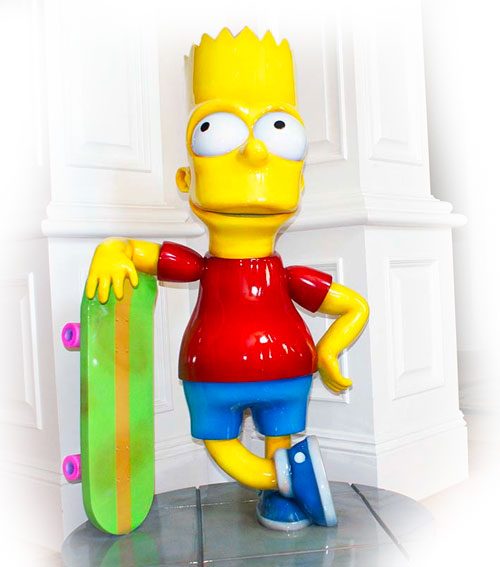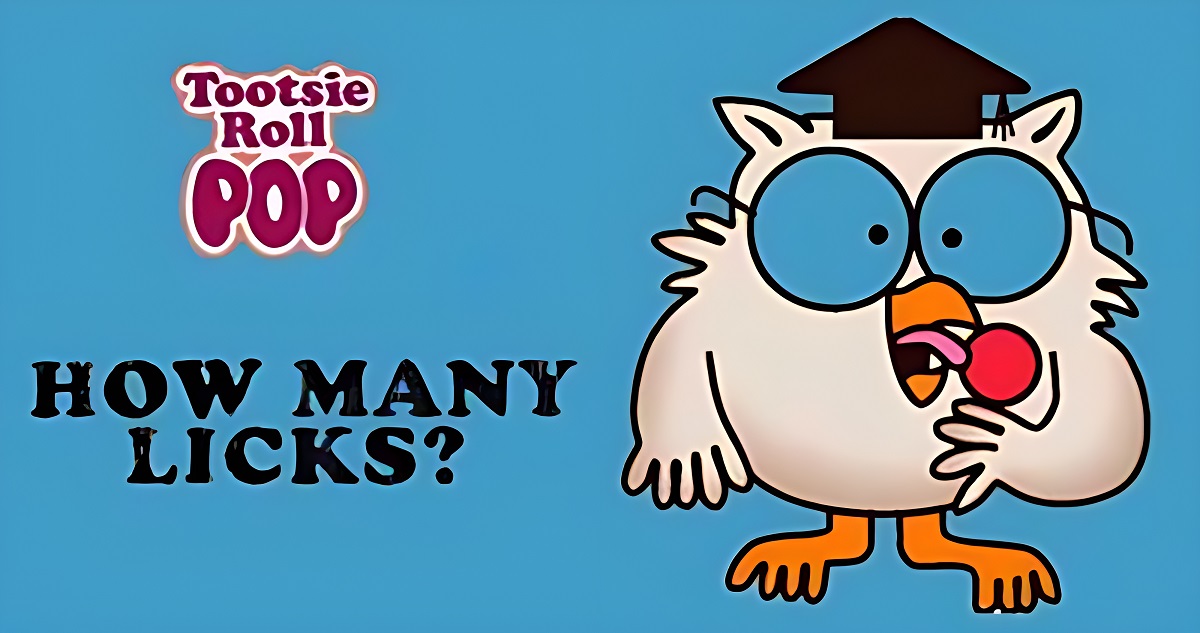Top 10 Candy Mascots
WhiteClouds builds 3D Large Characters
In the grand tapestry of confectionary wonders, candy mascots reign supreme as the heralds of sugary delight. They’re not just brand ambassadors, but entities that transform candies from mere edibles to tales of wonder, adventure, and nostalgia. With a twinkle in their eyes and mischief in their step, these mascots invite us to partake in a world where every bite is an odyssey, where every flavor unveils a story. From the whimsical realms of enchanted forests to the bustling lanes of New York City, these iconic figures have danced, laughed, and charmed their way into our hearts. Join us as we journey through the sweetest countdown, unraveling the magic behind the top 10 candy mascots that have shaped our confectionary dreams.
#1: M&M’s (Mars, Incorporated, 1941)
In the candy cosmos, few entities have a presence as dynamic and recognizable as the M&M’s. Beyond their delightful chocolate core and colorful candy shell, what truly brings M&M’s to life is their animated mascots. These vivacious, anthropomorphic candies, with distinct personalities, have been the face of the brand for decades, making M&M’s not just a treat, but a global phenomenon.
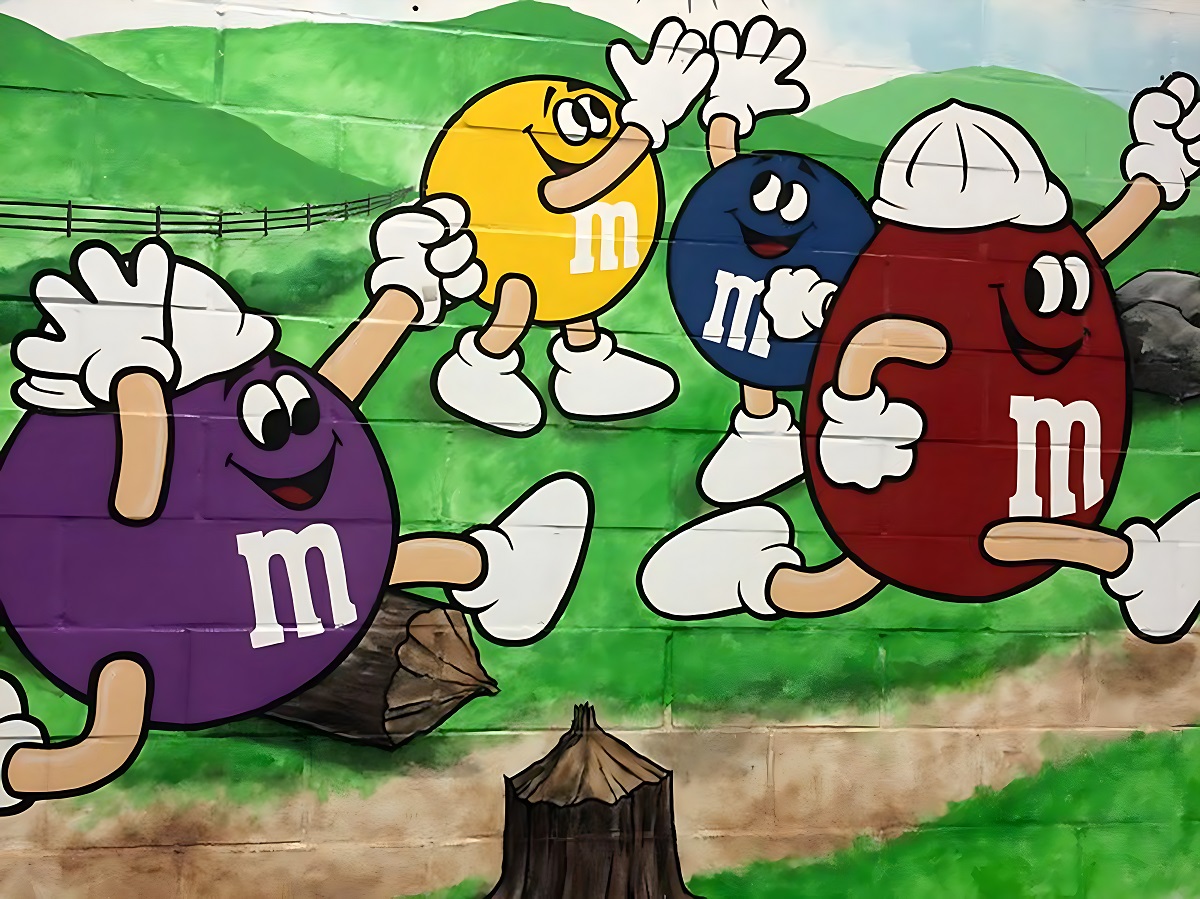
A Sweet Story Unfolds
Meet the M&M’s Ensemble
- Red: Often portrayed as the sarcastic and somewhat self-absorbed leader of the group.
- Yellow: The lovable, slightly dim-witted, and innocent character, often seen with Red.
- Green: The only female character for a long time, she’s depicted as sultry and confident.
- Blue: The cool, calm, and collected character introduced in the ’90s.
- Brown: Introduced later, Ms. Brown is sophisticated, smart, and often plays a straight-woman role to the antics of the others.
- Orange: The nervous, jittery character, paranoid about being eaten because he’s the “crispy” variant.
Why the Animated Candies?
Diverse Personalities: The varied personalities ensure that audiences can find at least one character they resonate with, or simply enjoy the dynamic they share.
Evolving Narratives: With mascots, M&M’s can create diverse advertising campaigns, from comedy skits to holiday specials, ensuring the brand remains fresh and engaging.
The Ensemble’s Escapades
Advertisements: From attempting to meet Santa to getting into amusing predicaments, the characters have made M&M’s commercials eagerly anticipated events.
Digital Engagements: Apps, games, and interactive websites, especially around voting campaigns for new flavors or colors, have been bolstered by these character-driven narratives.
Merchandise: From apparel to collectibles, the characters have found their way into the hearts and homes of fans worldwide.
Pop Culture Integration: These characters have mingled with celebrities, appeared during Super Bowl commercials, and even featured in movies, amplifying their cultural significance.
Marching Ahead with Mischief and Charm
As M&M’s continue to expand their flavor profiles and global reach, one thing is for sure: the M&M’s mascots will remain central to their story. They might see new adventures, embrace contemporary trends, or even welcome new members, but their essence—fun, quirky, and unmistakably M&M’s—will remain unchanged.
To sum it up, the M&M’s mascots are more than just marketing tools; they’re the heartbeat of the brand. Through their tales, trials, and triumphs, they invite us to experience a world where candies aren’t just treats but friends who add a dash of color and humor to our lives.
#2: Hershey Kiss (The Hershey Company, 1907)
In the orchestration of confections, few candies have struck a chord as timeless and melodious as the Hershey’s Kisses. These small, teardrop-shaped chocolates are more than just treats—they are emblematic of moments, celebrations, and a century of sweet memories. Beyond the iconic shape, there’s another aspect that has played a pivotal role in making these chocolates unforgettable: the charismatic, animated Hershey’s Kiss, often personified as a gleaming bell in commercials and campaigns.
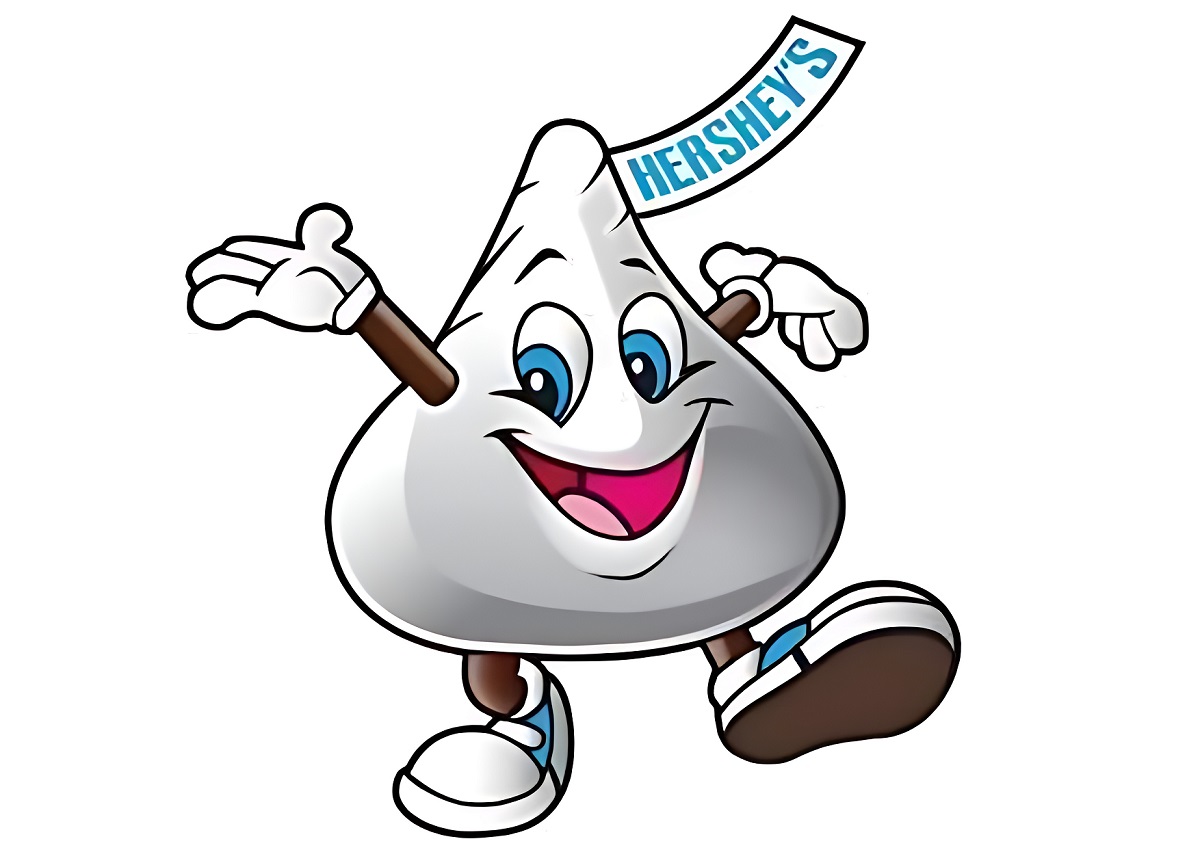
The Sweet Notes Begin
Hershey’s Kisses made their debut in 1907, with their name believed to be derived from the sound the machine made during the manufacturing process—a gentle “kiss” sound. This humble chocolate soon became a symbol of sharing and affection, cemented further by the introduction of the plume (or flag) in 1921, which made it easier to “unwrap a smile,” as some of the brand’s slogans suggest.
Ringing the Bells: The Animated Kiss
The Hershey’s Kiss, when animated in various brand promotions, often takes on the role of a cheerful bell. These animations have often shown the Kisses with their plumes acting like handles, ringing joyfully and adding a whimsical touch to the already-beloved chocolates.
Why the Bell Persona?
Shape and Sound Synergy: The teardrop shape of the Kiss naturally resembles a bell. Combine this with the “kiss” sound from its origin, and you have a delightful auditory and visual blend ready for animation.
Celebration Symbol: Bells often signify celebrations, joy, and announcements—aligning perfectly with the occasions Hershey’s Kisses are often part of, from holidays to everyday moments of joy.
Endearing Animations: The animations often portray the Kisses as characters with emotions, adding depth and personality to the chocolates, making them more memorable and lovable.
Melodies Across Mediums
Over the decades, the animated Hershey’s Kiss has been a recurring motif:
Advertisements: One of the most iconic commercials features a group of Hershey’s Kisses performing “We Wish You a Merry Christmas” as ringing bells, further cementing their image in festive celebrations.
Digital Engagements: Interactive games, digital greetings, and apps have featured these animated bells, ensuring that the younger audience remains as engaged as the older generations.
Seasonal Packaging: Special editions often have the Kisses personified on the packaging, adding a dash of character to the chocolates.
Merchandise: From T-shirts to Christmas ornaments, the animated Kisses have found their way into various forms of merchandise, making them part of broader cultural celebrations.
Echoing Into the Future
As the world of confections continues to be redefined with innovations, the Hershey’s Kiss stands strong, not just because of its delectable taste but also due to its iconic animated persona. While the animations might evolve with technology, the essence of the Hershey’s Kiss—as a bearer of joy, celebrations, and shared moments—will remain unchanged.
In wrapping up, the animated Hershey’s Kiss is not merely a marketing tool; it’s the heartbeat of a century-old chocolate tradition. Through its melodic ringing and cheerful animations, it evokes feelings of nostalgia, joy, and the simple pleasure of a chocolate kiss shared with loved ones.
#3: Tootsie Roll Owl (Tootsie Roll Industries, 1970)
Amid the sweet cacophony of candy brands, the Tootsie Roll has been a constant hum, a familiar and nostalgic treat that spans generations. And while its chewy, chocolatey goodness is unmistakably distinctive, its public image is also hugely characterized by one wise figure—the iconic Tootsie Roll Owl, Mr. Owl. With a sense of wisdom, humor, and a bit of mystery, Mr. Owl has been a guiding force in the Tootsie Roll’s journey through time.
A Timeless Treat’s Tale
The Tootsie Roll, originating in the early 1900s, has seen a century of change, from wartime rationing to the digital age. Its enduring appeal lies in its simplicity and consistent taste. However, as brands began seeking mascots to personify their products, Tootsie Roll introduced a character that would be forever linked with one of candy’s biggest mysteries.
Mr. Owl: The Curious Connoisseur
With big, bright eyes, a graduate cap symbolizing wisdom, and an ever-curious demeanor, Mr. Owl was introduced to the world with one mission: to determine how many licks it takes to get to the center of a Tootsie Roll Pop. This quest became the backdrop of one of the most memorable ad campaigns of all time.
Why Mr. Owl?
Symbolism: Owls, throughout literature and culture, have always symbolized wisdom. By choosing an owl, Tootsie Roll associated itself with a wise, thoughtful, and enduring image.
The Big Question: The advertisement’s question, “How many licks does it take to get to the center of a Tootsie Pop?” provided a fun and memorable way to emphasize the candy’s unique, hard shell with a chewy center composition. And who better to ponder this question than a wise old owl?
Nostalgia and Relatability: The playful nature of the commercial resonated with kids, while the philosophical undertone appealed to adults. Thus, Mr. Owl became an icon that multiple generations could relate to.
Mr. Owl’s Endeavors
While forever linked to the “How many licks?” campaign, Mr. Owl’s influence has stretched beyond:
Advertisements: Beyond the initial commercials, Mr. Owl has featured in various other narratives, always symbolizing a quest for knowledge or a solution.
Digital Engagements: In the digital age, Mr. Owl has been an ambassador on websites and social media platforms, continuing his quest and engaging with newer generations.
Merchandise: His recognizable figure has adorned numerous items, from T-shirts to school supplies, ensuring that the wise owl remains ever-present in fans’ lives.
Pop Culture Moments: The memorable commercial and Mr. Owl have been referenced in TV shows, movies, and even literature, proving its timeless appeal.
Soaring Towards a Wise Future
As candies evolve, and brands undergo transformations, Tootsie Roll and Mr. Owl share an unbreakable bond. Their stories are intertwined, symbolizing curiosity, wisdom, and the joy of discovery. While future campaigns might introduce new narratives, the essence of Mr. Owl’s quest will remain—a reminder of the simple joys and profound questions wrapped up in a humble candy.
In conclusion, Mr. Owl is more than a mascot; he is a sage, a philosopher, and a friend. Through his wise gaze and unwavering curiosity, he invites us all to partake in life’s sweet mysteries and enjoy the chewy revelations they unveil.
#4: Gummi Bears (Haribo, 1922 / Disney’s version, 1985)
Among the numerous candies that populate our imaginative world, gummi bears have carved out a distinctive and bouncy niche for themselves. Not only have these squishy, fruity, and colorful candies been favorites for many decades, but they’ve also been immortalized in popular culture, thanks largely to the animated series, “Disney’s Adventures of the Gummi Bears.” Let’s delve into the vibrant world of these legendary candies and their iconic mascots.
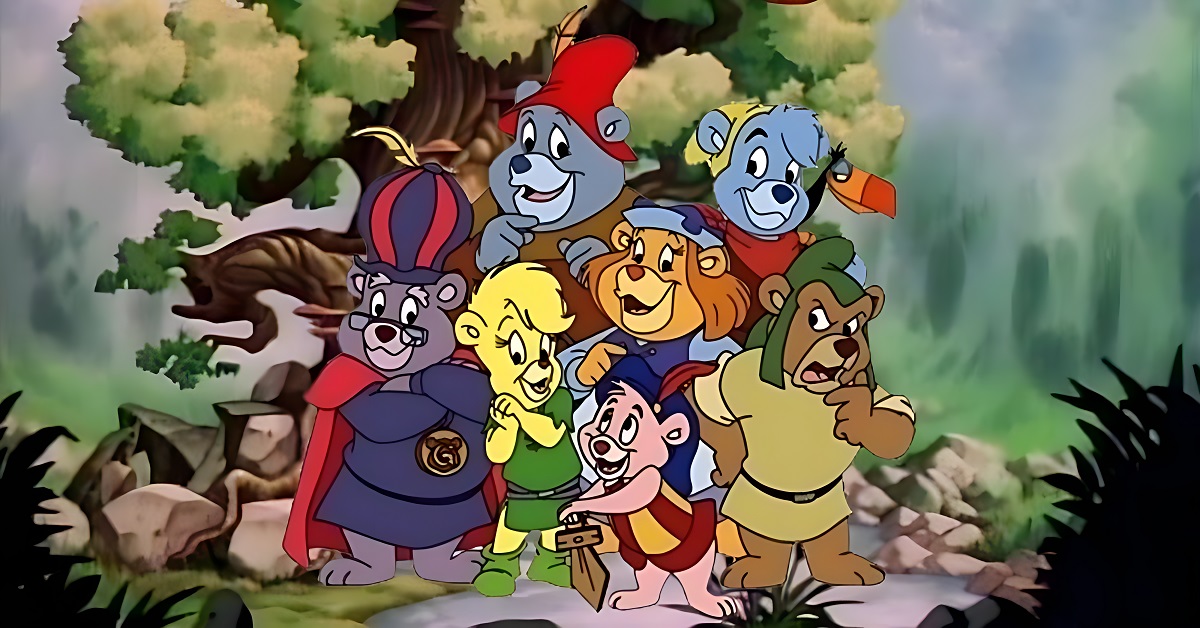
Origins: A Chewy Tale
Gummi bears originated in Germany in the 1920s by Haribo, which coined the term “Gummibär” (rubber bear). Their instant popularity can be attributed to their novel texture, brilliant colors, and fruity flavors.
Adventures of the Gummi Bears: Animated Ambassadors
While the actual candies don’t have a specific mascot, their animated counterparts, introduced by Disney in 1985, are a different story. The series portrayed a group of anthropomorphic bears with distinct personalities:
- Gruffi: The practical, mechanic, and sometimes grouchy bear.
- Zummi: The wise, old magician and keeper of Gummi history.
- Grammi: The caring, motherly figure who brewed the magical Gummi Berry Juice.
- Tummi: The laid-back, often hungry bear.
- Sunni: The young, adventurous, and optimistic one.
- Cubbi: The youngest and the most adventurous, dreaming of becoming a knight.
- Gusto: The artistic and free-spirited Gummi.
Why the Animated Gummi Bears?
Narrative Depth: The series added depth to the candy, turning them from mere chewable treats into characters with backstories, aspirations, and emotions.
Magic & Adventure: The Gummi Berry Juice, a potion that gives the bears the ability to bounce at high velocities, was central to the show, adding a sense of wonder and excitement.
Engaging Themes: Touching upon friendship, bravery, and the quest for knowledge, the series resonated with audiences both young and old.
The Bears’ Bouncing Influence
The animated Gummi Bears’ adventures extended far beyond their forest dwelling of Gummi Glen:
Advertisements: While not directly advertising the candy, the show’s popularity likely sparked increased interest and sales for gummi bears worldwide.
Merchandise: Toys, apparel, video games, and more have been released over the years, celebrating the bears’ adventures.
Cultural Impact: The show and its characters have found mentions in various other media, amplifying their legendary status.
Legacy: The series’ theme song and memorable episodes continue to be celebrated in nostalgic retrospectives.
Bouncing into Eternity
While the animated Gummi Bears aren’t official mascots for the candy, their influence on popularizing and endearing the gummi bear to audiences is undeniable. Their tales of valor, magic, and camaraderie have left an indelible mark on pop culture.
In wrapping up, the Gummi Bears, both as candies and animated characters, invite us into a world of imagination, wonder, and sweetness. Their legacy reminds us that even the simplest of treats can spawn legends, tales, and adventures that continue to delight generation after generation.
#5: Sour Patch Kids (Mondelez International, 1985)
In the kaleidoscope of candies, the Sour Patch Kids stand out not just for their unique taste profile but also for their vibrant personality. This iconic candy, which tantalizingly teases with a sour start and a sweet finish, has carved its own niche in the confectionary universe. This isn’t only because of its taste but also due to the mischievously endearing characters that represent them: the Sour Patch Kids themselves.
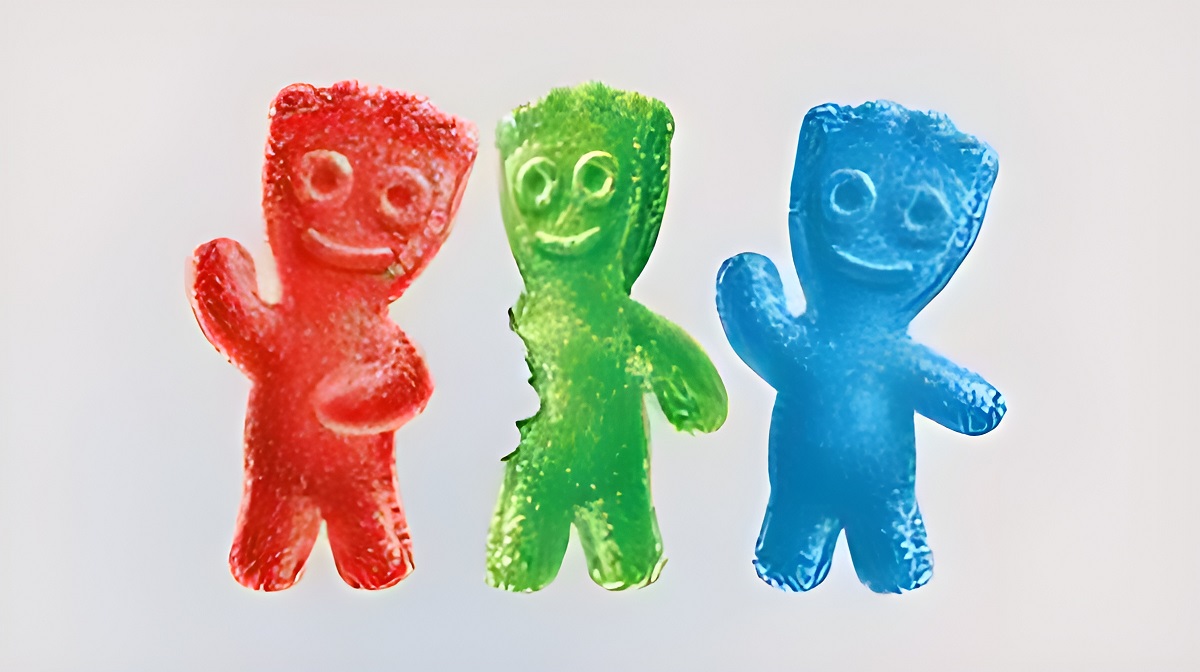
A Tangy Tale Begins
Introduced in the 1970s as “Mars Men” before being renamed, the Sour Patch Kids were a response to the growing popularity of sour candies. Their unique shape, reminiscent of little children, combined with their distinct sour-then-sweet flavoring, made them an instant hit.
Personifying the Candy: The Sour Patch Characters
Unlike many other candies, where mascots are separate entities, the Sour Patch Kids themselves are the mascots. These humanoid gummy figures, with their wry smiles and playful postures, are the embodiment of the candy’s essence.
Why the Mischievous Kids?
Flavor Representation: The sour-then-sweet taste transition is cleverly portrayed in the kids’ personalities. They start with mischievous antics, symbolic of the initial sour kick, and then end with a kind gesture, echoing the sweet conclusion.
Relatability: Every individual, at some point in their childhood, has exhibited a blend of mischief and sweetness, making these characters universally relatable.
Memorability: Their playful demeanor is instantly recognizable, ensuring that the candy remains memorable in the minds of consumers.
Playful Antics Across Platforms
The Sour Patch Kids have been more than just static figures on packaging. They’ve come to life in various ways:
Advertisements: TV commercials often show the Sour Patch Kids playing pranks on unsuspecting humans, followed by a sweet gesture, aligning with their sour-then-sweet theme.
Digital Presence: From video games to social media campaigns, these mischievous kids have embraced the digital age, continuing to engage and entertain their audience.
Merchandise: Their iconic figures have found their way onto a range of products, from clothing to collectibles, further amplifying their cultural relevance.
Cultural Impact: The characters’ distinctive personalities have made them a part of pop culture references, music videos, and even celebrity endorsements.
A Future Sprinkled with Mischief and Sweetness
As the world of candies continues to evolve and expand, the Sour Patch Kids remain evergreen in their appeal. Their design might undergo subtle tweaks, and their digital avatars might get more sophisticated, but the essence of the Sour Patch Kids – a blend of playful mischief and heartwarming sweetness – will remain unchanged.
The Sour Patch Kids are not merely candies; they’re characters with stories, emotions, and a delightful duality. They remind us of the playful innocence of childhood and the joy of unexpected flavor journeys, making them an enduring favorite across generations.
#6: Nerds (Nestlé, 1983)
In the colorful and vast candy landscape, Nerds stand out, not just for their dual-flavored boxes and crunch but also for their distinctive characters. These tiny, pebble-like candies have become a symbol of playful eccentricity and whimsy, a sentiment captured perfectly by the Nerds’ mascots: two contrasting yet endearing characters that adorn every package.
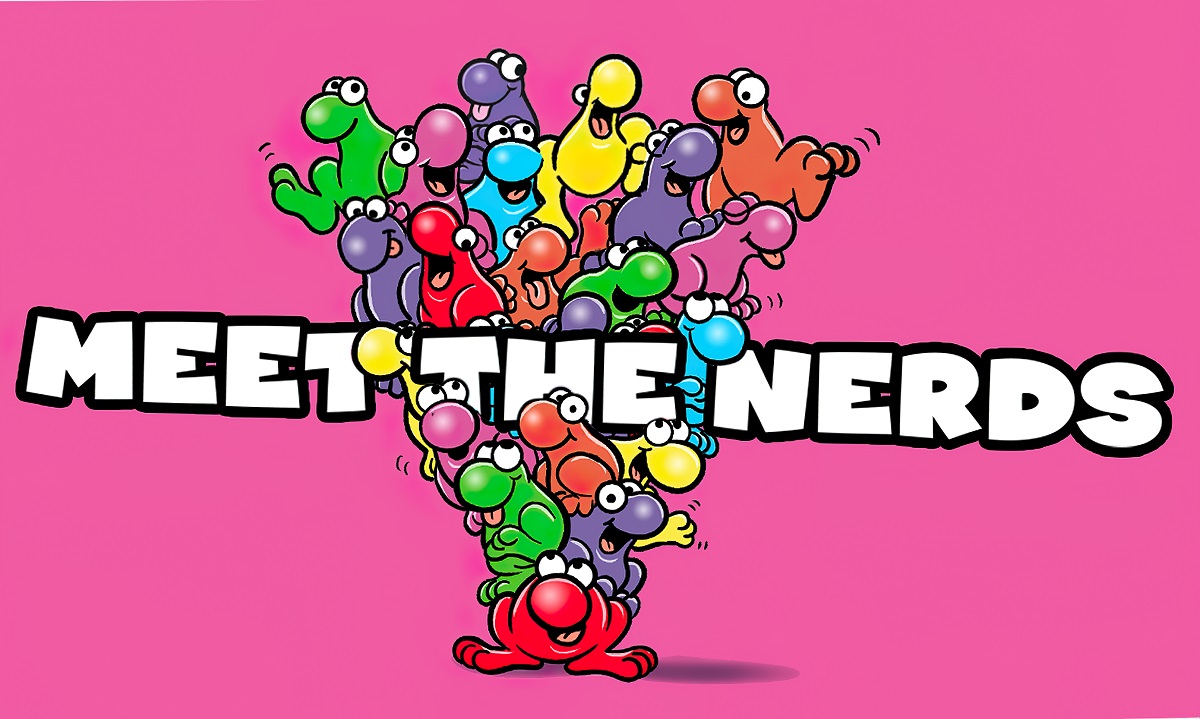
A Crunchy Adventure Begins
Nerds were introduced in 1983 by the Willy Wonka Candy Factory, a brand with a reputation for concocting imaginative and whimsical treats. True to form, Nerds quickly garnered attention for their novel presentation: two separate flavors in a divided box, allowing candy enthusiasts to savor them either separately or in a delightful mix.
Meet the Nerd Duo: The Personified Candies
While many candies opt for anthropomorphic mascots, Nerds took it a step further. The two characters representing the candy are literally nerdy Nerds—complete with glasses, exaggerated smiles or frowns, and a sense of quirky charm.
Why the Nerdy Duo?
Name Embodiment: The term “nerd” often refers to someone deeply enthusiastic or knowledgeable about particular subjects, showing a kind of endearing quirkiness. By turning this into a character, the candy playfully embraces its name, presenting it as something fun and delightful.
Flavor Contrast: Each box usually contains two different flavors. The contrasting characters on the packaging signify this duality, allowing consumers to identify the two flavor profiles at a glance.
Relatability and Humor: Everyone has a bit of ‘nerd’ in them, be it in passion, quirks, or tastes. The characters, in their exaggerated expressions, tap into this universal sentiment, making the candy more personable and memorable.
The Duo’s Adventures Across Platforms
The Nerds’ mascots have played various roles over the years:
Advertisements: The characters have come to life in animated commercials, showcasing their personalities and the playful essence of the candy.
Digital Engagements: From interactive websites to social media animations, the Nerds characters continue to engage with their audience in the digital age.
Merchandise: Their unique designs have made their way into various merchandise, from apparel to school supplies, solidifying their presence beyond the candy aisle.
Collaborations and Special Editions: Limited-edition flavors or collaborative releases often feature modified versions of the characters, catering to the theme or the partnering brand.
Dancing into the Future
As candies evolve and brands undergo revamps, the Nerds, with their distinctive personalities and flavors, are here to stay. While their appearances might see subtle changes, the quirky spirit of the Nerds mascots is sure to remain a constant.
In conclusion, the Nerds mascots aren’t just decorative elements on a candy box; they encapsulate the brand’s spirit—playful, eccentric, and unabashedly fun. Through their vibrant expressions and adventures, they remind us that it’s okay to embrace our quirks and enjoy the little crunches of joy in life.
#7: Dum Dum Drums (Spangler Candy Company, 1924)
In the vast universe of candies, there are those that evoke not just flavors on our tongues, but also fond memories in our hearts. Dum Dums, those little, brightly-colored lollipops, have been a source of joy for generations. As simple as they may seem, there’s a heartbeat behind them – and that’s captured perfectly in the mascot, the Dum Dums Drum Man.
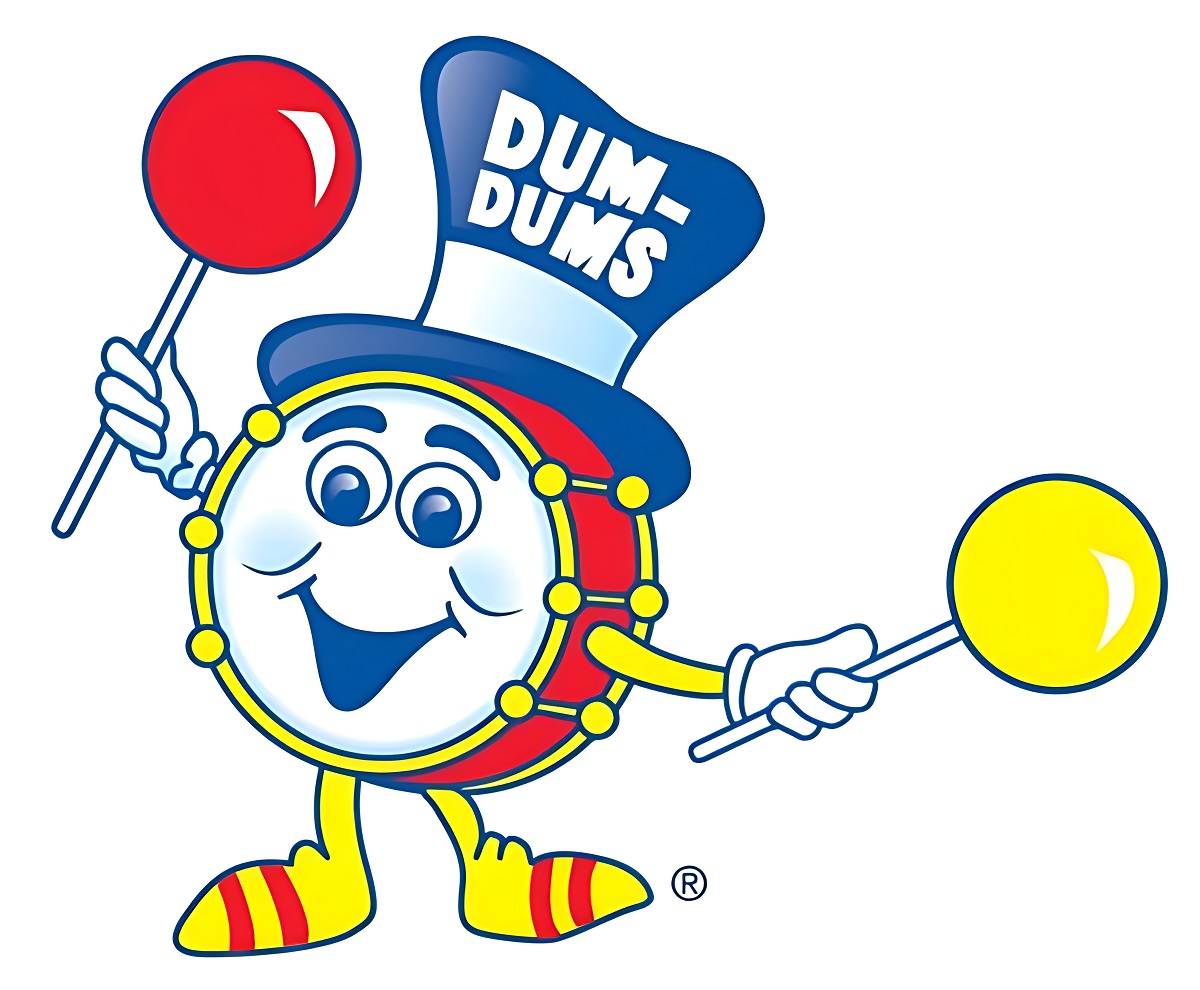
The Flavorful Beginning
Dum Dums were introduced to the world in 1924 by the Akron Candy Company and were eventually acquired by Spangler Candy Company in 1953. Originally, they were intended to be a lightweight, inexpensive complementary candy for kids. Little did they know, these pops would become a staple in homes, banks, and barber shops across America.
The Beat of the Dum Dums Drum Man
Resembling the shape of a lollipop, the Drum Man is an anthropomorphic drum, complete with arms, legs, and a wide, ever-present smile. He’s not just a symbol; he’s a reminder of the joy and rhythm that these candies bring to life.
Why a Drum?
Dum Dums, phonetically echoing the beat of a drum, playfully mimic the repetitive “dum-dum” sound. The mascot is a manifestation of this sound, breathing life into the candy’s name. The Drum Man’s cheerful demeanor is a nod to the lighthearted fun and happiness the candies bring.
Striking a Chord with the Audience
Over the decades, the Drum Man has played a few key roles:
A Beacon of Recognition: Even from a distance, the sight of the jolly Drum Man on packaging or promotional material instantly brings to mind the sweet, varied flavors of Dum Dums.
Merchandise Magic: The Drum Man has graced various merchandise, from T-shirts to collectibles, further entrenching the brand’s presence in popular culture.
Promotions and Events: The mascot, with its universal appeal, has often been the centerpiece in events, campaigns, and community outreach programs.
Evoking Nostalgia: For many adults, the Drum Man is a trip down memory lane, a sweet reminder of yesteryears and simpler times.
The Drumbeat of the Future
Candies evolve, flavors come and go, but classics like Dum Dums continue to hold their ground. As they journey into the future, it’s likely that the Dum Dums Drum Man will see evolutions in design or digital adaptions. Still, his essence will remain the same – a symbol of the consistent joy that these little lollipops bring to the world.
In conclusion, the Dum Dums Drum Man isn’t just a mascot. He is a testament to the legacy of a candy that has danced its way into hearts across generations. In his cheerful beat and radiant smile, we find the essence of every little Dum Dums pop – pure, simple, and timeless joy.
#8: Life Savers (Clarence Crane, 1912)
Life Savers, with their iconic ring shape, are more than just candies; they’re pieces of history and nostalgia that have graced the palates of many for over a century. These candies, celebrated for their distinctive form and refreshing flavors, are embedded in popular culture. But there’s a lesser-known facet of this brand story – the Life Savers mascot. While not as prominent as some, its presence over the years has complemented the candy’s legacy.
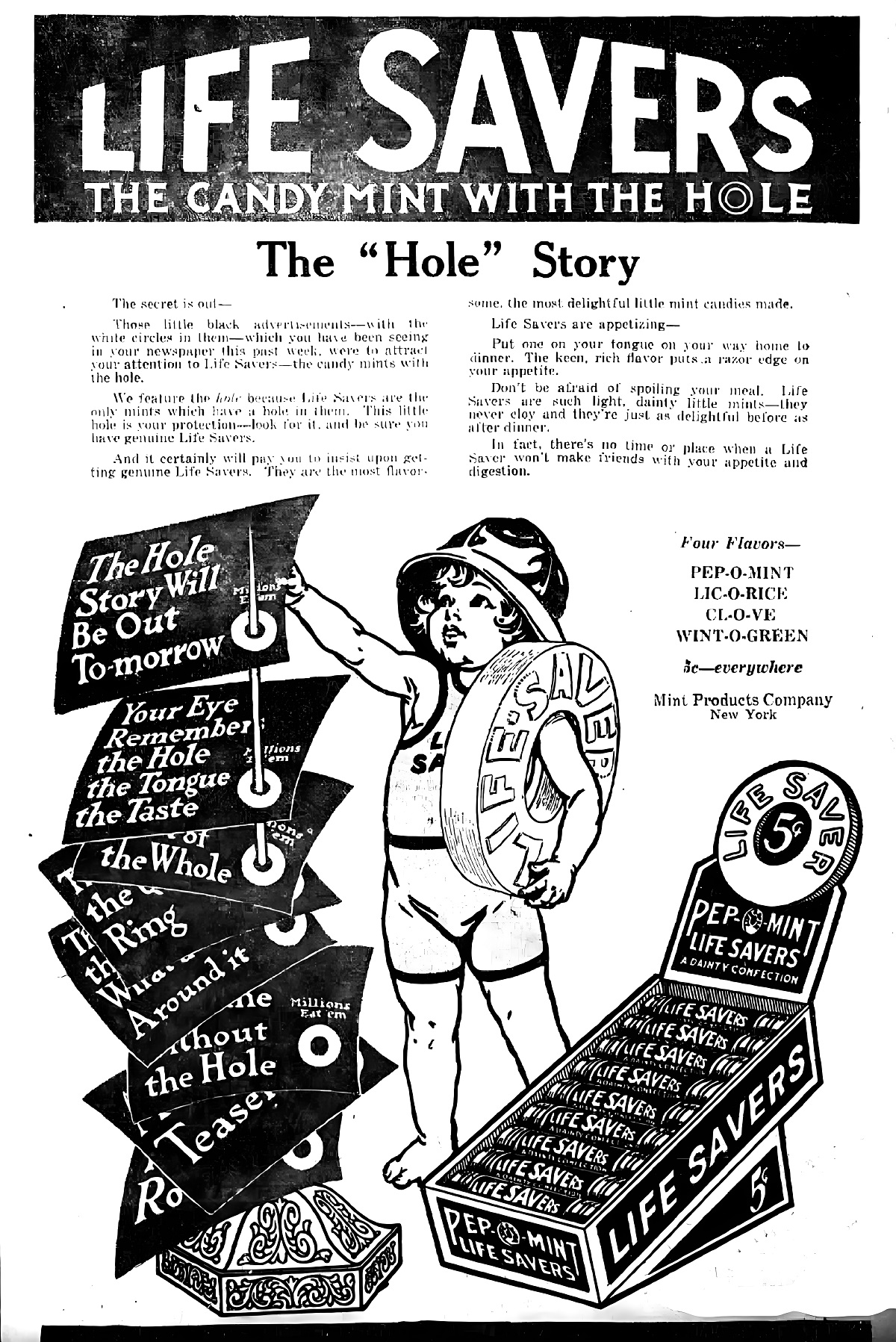
Setting Sail into History
Life Savers came to life in 1912, introduced by Clarence Crane. He envisioned a summer-friendly candy alternative to chocolates that wouldn’t melt. Inspired by the shape of life preservers found on boats, Crane shaped the candy into circles with a hole in the middle, and thus, Life Savers were born.
The Lighthouse: Guiding Light of Sweetness
Though not anthropomorphic or character-based like many candy mascots, Life Savers have occasionally used the imagery of a lighthouse in their promotional materials. The lighthouse, standing tall amidst turbulent seas, emitting a guiding light, aligns with the brand’s name and the candy’s design.
Why the Lighthouse?
Symbolism: Much like the lifebuoy ring shape of the candy, lighthouses are symbols of safety, guidance, and hope. They lead the way in the darkest nights and the stormiest seas, much like how Life Savers have been a comforting and refreshing presence in the candy world.
Historical Roots: Given that the Life Savers candy design was inspired by maritime safety equipment, the lighthouse feels like a natural extension of the brand’s nautical theme.
A Light in Memories: Lighthouses often evoke a sense of nostalgia, mystery, and timeless beauty – sentiments that align well with the legacy of Life Savers.
Shining Through the Ages
The lighthouse, as a symbolic mascot, has illuminated the brand in various ways:
Packaging Elegance: Older packaging designs occasionally incorporated the lighthouse, reinforcing the theme of safety and guidance.
Advertisements: Vintage ads sometimes depicted the beacon of light guiding individuals to the refreshing taste of Life Savers.
Narrative Symbol: In brand storytelling, the lighthouse served as a reminder of the candy’s origin, its inspiration, and its commitment to being a consistent, reliable treat.
The Beacon’s Future Glow
While the lighthouse isn’t as overtly present in modern branding as it might have been in the past, it remains a testament to the brand’s origins and values. As Life Savers navigate the future, embracing new flavors and trends, the symbolic lighthouse could very well see a revival or modern reinterpretation.
In summary, while Life Savers themselves are the main stars, the subtle touch of the lighthouse as a mascot serves as a grounding and evocative beacon. It’s a reminder of the brand’s roots, its commitment to refreshing quality, and the countless memories it has illuminated over the decades.
#9: Milky Way Cow (Mars, Incorporated, 1923)
When it comes to the galaxy of chocolate bars, the Milky Way shines brightly. But there’s more to its allure than just nougat and caramel. The Milky Way brand has another star, a more subtle ambassador, but one that captures the imagination as much as the bar satisfies the palate: the Milky Way cow. While not as renowned as some candy mascots, this bovine beauty has a sweet tale worth telling.
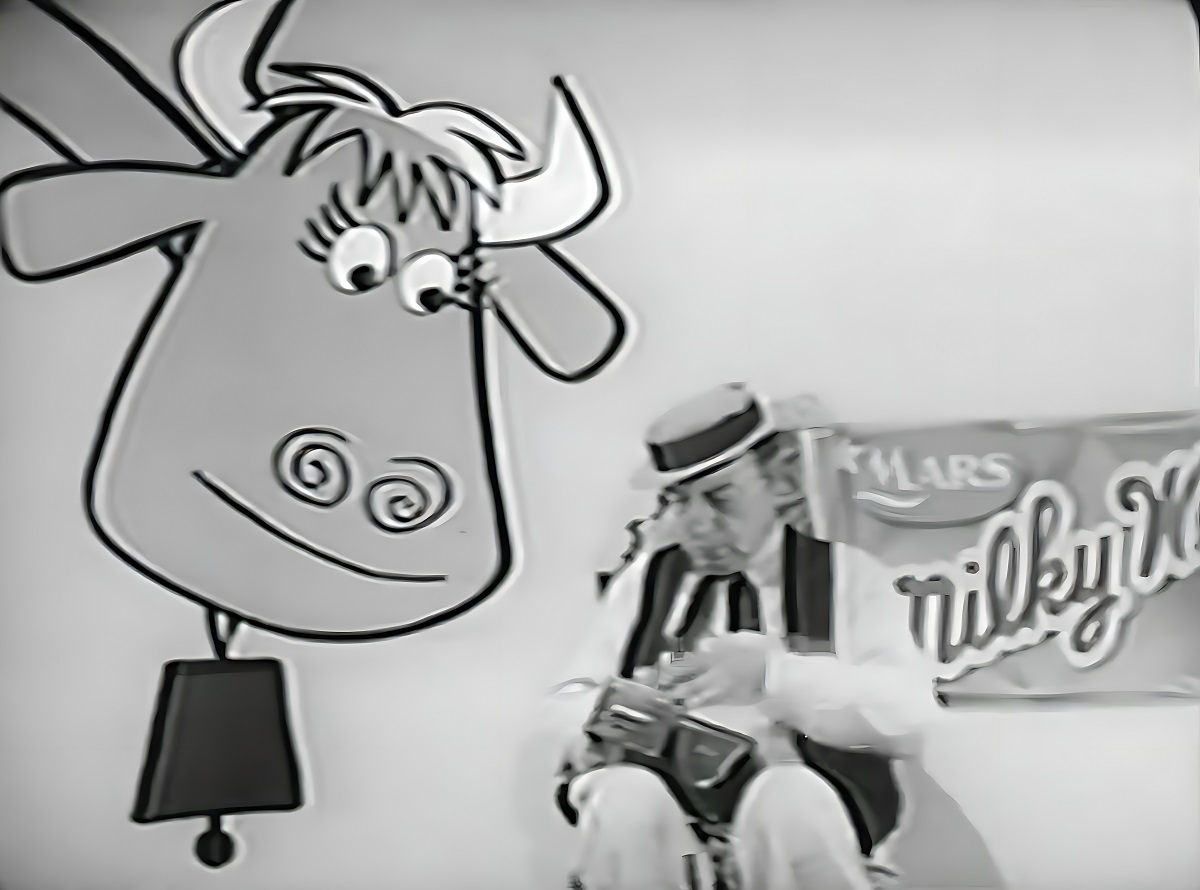
Journey Beyond the Stars
The Milky Way bar, introduced in 1923 by the Mars company, was designed to taste like a malted milkshake. This concept is crucial in understanding the importance of the cow mascot. The bar’s foundation, both in flavor and branding, ties back to the malted milk – and what symbolizes milk better than a cow?
The Milky Way Cow: From Pasture to Package
With the rich malt flavor and milk chocolate exterior, the cow seemed like a fitting emblem. It was a natural, wholesome symbol that made consumers think of fresh milk and creaminess. It was, in essence, a promise of quality and taste, whispering that the chocolate they were about to indulge in was as fresh as the morning’s first milking.
The cow also gave the brand a rustic, down-to-earth feel. In an age when mass production was becoming the norm, this touch of pastoral nostalgia was comforting.
The Subtleties of Stardom
While not as prominently featured as some candy mascots, the Milky Way cow has been a quiet constant for the brand. Here’s how:
A Symbol of Quality: For many, the cow became a subconscious assurance of quality, reinforcing the idea of fresh ingredients and a bar brimming with creamy goodness.
Marketing and Campaigns: Over the years, the Milky Way cow has graced various advertisements, playing a serene background character to the main event: the chocolate bar itself.
A Reminder of Origins: The cow serves as a bridge, connecting the modern, ever-evolving Milky Way bar to its malted milkshake-inspired origins.
A Conversation Starter: The subtle inclusion of a cow for a galaxy-themed chocolate bar has often piqued curiosity, leading to discussions and a deeper dive into the brand’s history.
The Cow in the Cosmic Dance
The future looks bright and starry for the Milky Way bar, and as the brand explores new flavors, textures, and markets, the cow’s role may evolve. While it might not always be in the spotlight, its legacy as a bridge between the bar’s past and present will always be cherished.
The Milky Way cow, with its gentle presence, has become an emblem of nostalgia, quality, and innovation for the brand. It serves as a delightful reminder that sometimes, the most powerful symbols are the ones that silently resonate, reminding us of the roots from which we’ve grown and the galaxies we’re yet to explore.
#10: Jelly Bellies (Jelly Belly Candy Company, 1976)
When it comes to candies, not many can boast of the colorful history and charm of Jelly Belly. And like all iconic brands, the face that represents them – their mascot – plays a pivotal role in their identity. For Jelly Belly, that emblematic face has been a delightful evolution.
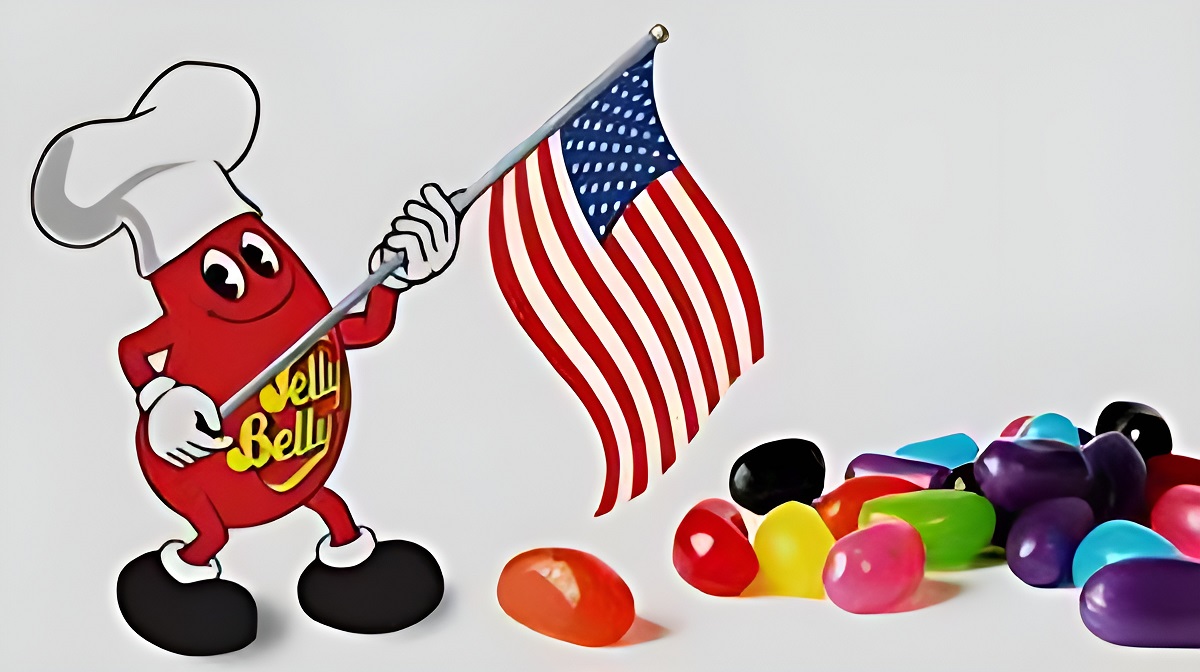
The Genesis of Gourmet
Jelly Belly, known for its gourmet jelly beans, began its journey in 1976. However, its lineage can be traced back to the 1860s, when Gustav Goelitz started the candy business, which eventually led to the creation of the Jelly Belly Candy Company. But the beans aren’t the sole stars of the show; the mascot has its own tale to tell.
Mr. Jelly Belly: The Beaming Bean
When you think of Jelly Belly, one image comes instantly to mind – that of Mr. Jelly Belly, the anthropomorphic jelly bean with a radiant smile, large eyes, and a bouncy personality. Donning a large red bowtie and those ever-shining shoes, Mr. Jelly Belly became a fun, interactive way of engaging with audiences, especially children.
However, this mascot didn’t just appear out of thin air. It took years of branding, understanding market dynamics, and a bit of whimsy to give birth to this character.
From Beans to Beaming Personality
Before Mr. Jelly Belly, the beans were promoted largely based on their quality, variety of flavors, and uniqueness in the candy world. They were the first to introduce flavors that matched their colors, and their “true-to-life” tastes were their major selling point. As the beans gained popularity, the brand realized the potential of having a mascot – a symbolic representation that people could associate with the candy.
Mascots have a unique power to make brands more relatable, providing them with a face and personality. Thus, Mr. Jelly Belly was conceived to be the epitome of fun and joy – just like the beans themselves. His design was chosen to be simple yet memorable, and the character was positioned to be jovial, welcoming, and full of energy.
The Role of Mr. Jelly Belly
Over the years, Mr. Jelly Belly has done more than just adorn the packaging. He’s been instrumental in:
Promotions and Events: Mr. Jelly Belly, with his infectious charm, has been the star of numerous promotional events, factory tours, and candy launches.
Merchandising: The mascot’s likable image has found its way onto various merchandise, from T-shirts to toys.
Digital Engagement: In today’s digital age, Mr. Jelly Belly isn’t just a static image. He’s animated, interactive, and plays a crucial role in the brand’s online campaigns.
Endearing the Brand to Younger Audiences: While the candy appeals to all age groups, Mr. Jelly Belly especially resonates with children, making them eager ambassadors of the candy.
Future of the Beaming Bean
As Jelly Belly continues to expand its flavor palette and reach global markets, the role of its mascot becomes even more essential. In an age where brand recognition is paramount, Mr. Jelly Belly stands as a beacon of consistency and joy. The character may evolve, animations might get more sophisticated, and merchandise more diverse, but the essence of Mr. Jelly Belly will remain unchanged – a representation of the pure delight that Jelly Belly brings to its consumers.
While Jelly Belly beans are a feast for the taste buds, Mr. Jelly Belly is a treat for the heart and soul. Together, they encapsulate the brand’s journey from a humble bean to an iconic global candy sensation.
And so, as our sugary sojourn from our Top 10 candy mascots draws to a close, we’re left with the echoing laughter and vibrant tales of the mascots who’ve been the heartbeats of their respective brands. They’ve been more than just animated figures on our screens; they’ve been companions of our childhood, guardians of our fondest memories, and the magical bridge between reality and the world of candies. In celebrating them, we celebrate moments of joy, innocence, and boundless imagination. May the tales of these candy mascots continue to sprinkle sweetness in our lives, reminding us that magic, wonder, and a touch of mischief are but a candy away.
Candy Mascots to Physical 3D Forms
In the enchanting realm of confections, candy mascots have long been the spirited guardians of sugary treasures. These vibrant characters, once confined to the flat world of packaging and commercials, are now crossing the threshold into our tangible reality, thanks to the wonders of 3D printing and design.
Imagine strolling through a park and stumbling upon a life-sized M&M character, its glossy shell reflecting the sun, inviting you for a playful selfie. Or perhaps you’ve always dreamt of having tea with the Tootsie Roll Owl? With the advancement of 3D technologies, these mascots are being sculpted into statues, toys, and even interactive installations. The 3D incarnations bring with them a touch of their whimsical worlds, blurring the boundaries between the fantastical candy lands of our imaginations and our own physical realm. As these mascots transition into 3D forms, they’re not just symbols of our favorite treats but become tangible companions, solidifying our connection to the sweet memories of yesteryears and the promise of delightful tomorrows.
Learn more about 3D Characters
See our all-inclusive 409 Cereal Mascots. Learn more about our Mascots at Candy Mascots or 3D Mascots.
Contact us today to learn more about our services and how we can help you achieve your goals.
